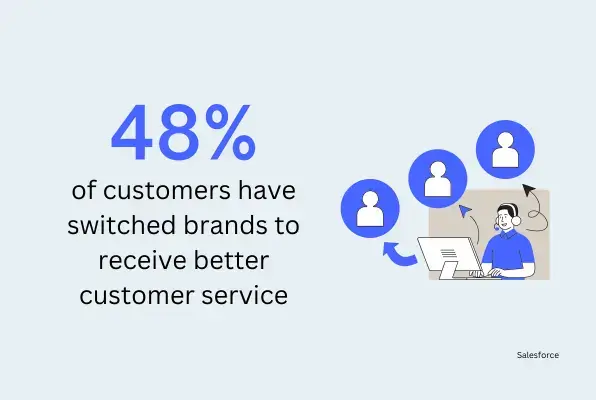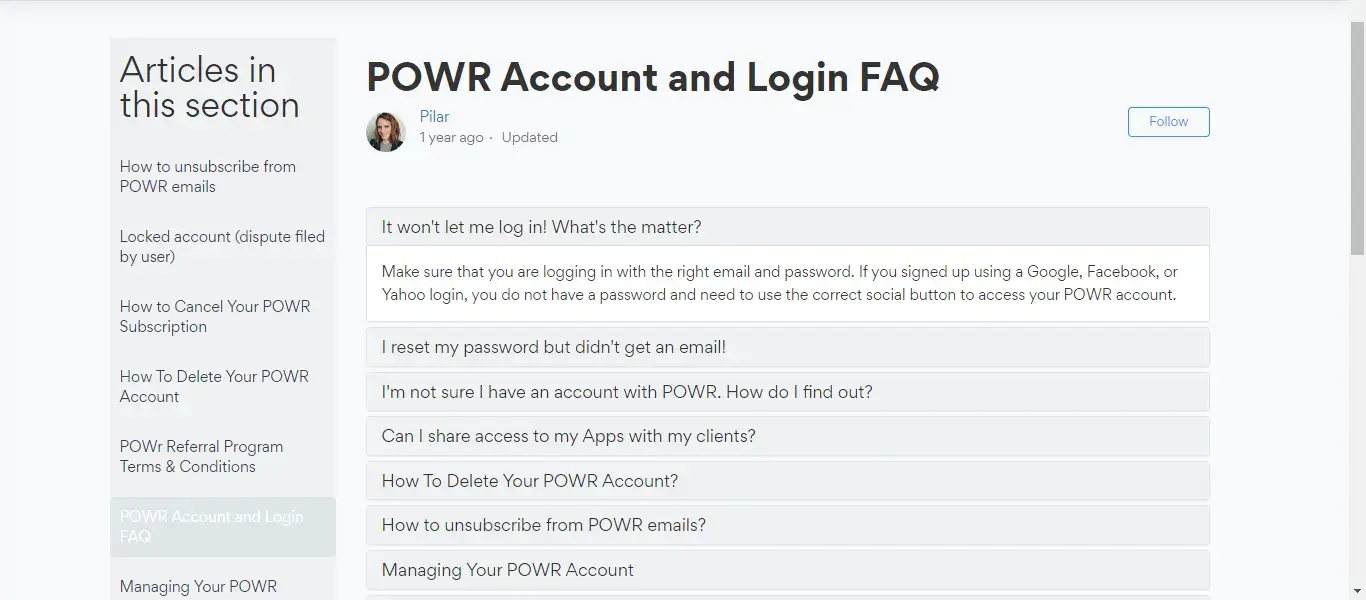While there’s no replacing the value of your live support agents, customer self-service drives critical, high-demand customer experience improvements.
Consistency. Flexibility. Convenience. Speed. Customers want support experiences that meet these needs and are willing to abandon brands that don’t provide them.
According to Salesforce, 71% of customers have switched brands in the last year. 48% of these customers cite better customer service as one of the main reasons why.

Image Created by writer Data sourced from Salesforce
Customer self-service is a leading eCommerce trend that can give your small business a competitive edge.
This article will discuss the business-optimizing and loyalty-boosting benefits of self-service and the different types of self-service you can implement. We’ll throw in a few best practices at the end, too.
What is Customer Self-Service?
Customer self-service enables customers to resolve problems independently.
Instead of waiting for ages to speak to a customer support agent, they can utilize self-service tools and resources like chatbots, community forums, and online knowledge bases.
One of the most important things to remember is this: self-service isn’t there to replace your agents. It complements their expertise, streamlines their workflows, and empowers them to deliver better customer experiences.
Finding the right balance between live agent support and customer self-service is the key to unlocking the benefits discussed below.
The Benefits of Customer Self-Service
Customer self-service is a win-win solution for customers and companies. From faster resolution times to increased employee productivity and lower customer service costs, let’s look at the leading benefits of self-service.
-
24/7 availability for round-the-clock global support
Customer issues don’t stop once your agents clock out. By delivering self-service options to your customers, you can provide round-the-clock customer support —whether during the early morning hours or on a Sunday afternoon.
Always-on availability lowers customer churn and increases customer satisfaction. Customers can receive an immediate resolution to their issues regardless of their time zone or your company’s operating hours.
It also reduces the sky-high expenses of managing a 24/7 customer service team.
-
More cost savings
It’s simple—the fewer calls you have coming into your customer service team, the fewer agents you need to manage them. And with the ability to offer 24/7 self-service support, you can reduce the expenses incurred by out-of-hours agents.
Self-service interactions are considerably cheaper than human interactions. If you’re a small business, this can significantly free up your budget. Why not use these extra funds to invest in training, better equipment, and other business-improving resources?
-
Faster resolution times to satisfy customers
Some customer service problems require skilled, meticulous human intervention. But for simpler issues, self-service delivers a quicker, more optimal customer experience.
66% of Millennials and 61% of Gen Z-ers prefer self-service to resolve simple problems. Why? Because they facilitate the immediacy that traditional support can’t provide.

Image sourced from Salesforce
Chatbots are more than capable of answering basic queries. Searchable online FAQs and knowledge bases can provide limitless answers and solutions.
Product tutorials can provide thorough visual demonstrations that facilitate self-service. And all of these options are much faster than receiving human support—especially during peak call periods.
Customers don't need to find your customer support number, wait to connect to an agent, explain the issue to an agent (sometimes repeatedly), and then work with the agent to resolve the issue. They can simply hop online and solve their problem in minutes.
-
Increased employee productivity for bottom-line growth
Eliminating the need for a 24/7 customer support team isn’t the only financial benefit of self-service. Increased efficiency and productivity are the actual cost benefits that you’re providing to your agents.
Automated self-service streamlines backend workflows and results in fewer calls to your customer service team.
So instead of managing hoards of tedious calls, agents can focus their attention on customers calling in with more complex issues.
The result? Employees can deliver more personalized, valuable experiences to customers in need.
And with the help of effective VoIP pricing, you can optimize costs even further by utilizing VoIP to deliver IVR, improve call routing, and empower agents to answer calls from any location on any device. It boosts customer satisfaction, customerretention, and customer loyalty, which drive more conversions and revenue.
-
Better customer experiences
Salesforce discovered that 83% of customers expect immediate interaction with your customer service agents. This finding has significant implications for various Salesforce roles, from front-line support to management.
Tools like the Salesforce Data Migration Tool also play a key role in ensuring that historical customer data is accurately transferred and accessible, giving service agents the context they need to respond quickly and effectively.
But when you have high call volumes, even the most competent customer service teams can struggle to meet this expectation. It can easily result in increased volumes of missed calls, poorly-handled calls, and frustrated, unhappy customers.
And by no coincidence, service agents say that dealing with unhappy customers is their biggest day-to-day challenge.
Unsurprisingly, this is followed by “not having enough time in the day” for high and low-growth companies at 43% and 51%, respectively.

Image sourced from Hubspot
Effective, streamlined self-service allows customers to enjoy flexible, convenient customer experiences. It frees them from the long queues, opening time restrictions, and frustrating back-and-forth (mis)communications that plague live support.
Should they need to contact an agent, they can enjoy shorter queues, increased agent engagement, and faster time-to-resolution—all thanks to self-service.
The Types of Customer Self-Service You Should Invest In
Different self-service options meet different needs. So, what are the main ones that you should consider investing in?
-
Chatbots
They are automated, AI-powered virtual assistants that simulate sales representatives and improve sales. You can program them to converse with customers and respond to common queries across web, mobile, and social media channels.
And through CRM integration, they can even use customer data to deliver personalized experiences.
According to Salesforce, the number of businesses using chatbots has grown from 43% to 58% in the last two years alone.
This ever-increasing adoption is making so many waves that Gartner predicts chatbots will become the primary customer service channel for 25% of businesses by as soon as 2027.
-
Online Knowledge Bases and Help Centers
A knowledge base, or Help Center is essentially an online self-service library. It provides customers with instructive and informational resources, including in-depth articles, FAQs, product tutorials and manuals, company information, and more.
Here’s what the knowledge base looks like at POWR:

Screenshot taken by writer
You can significantly boost customer success with a knowledge base that is well-designed and comprehensive. To meet your customer’s needs, create a knowledge base that is accessible via your website, contains organized, logical categories and sub-categories, and includes a search function.
-
IVR Systems
An IVR system is a prime example of using self-service options to complement live customer support teams. Interactive voice response systems, or IVRs, are automated telephone technology that uses speech recognition to interact with incoming callers.
When customers call your support line, they will have a menu to self-direct themselves to the right place.
IVR can answer simple questions and route customers to the correct department or agent, reducing hold times and driving quicker resolutions.
It can even direct customers to an alternative channel when phone lines are busy to improve resolution times.
-
Community forums
A community forum is an online platform where customers can answer each other’s questions and discuss your products and services.
Customers in need can post a question to the forum themselves or look at old threads to find solutions to their problems. Customers have a perspective that your agents don’t. It can make them an excellent resource as they can frame answers through the customer lens, leading to more precise, faster solutions.
As well as enabling customers to resolve problems faster, online forums have the added benefit of creating a community around your brand. Customers can forge social connections with each other, which is a powerful driver of retention.
If you’re a global business, consider hosting online community forums on localized domains. For example, if you have customers in Hong Kong, you’d use a .hk domain if you had customers in the UK, you’d use .uk.
-
FAQ pages
An FAQ page on your website answers all your most frequently asked questions.
They’re often one of the first touchpoints for customers with simple questions about your products and services, as they provide solutions much faster than contacting customer support.
Although your FAQ page needn’t be as comprehensive as your knowledge base, it should still aim to answer as many questions as possible.
To improve customer experiences, organize your FAQs into organized categories and construct questions and answers clearly and concisely.

Screenshot taken by writer
Customer Self-Service Best Practices
There’s a right way and a wrong way to implement customer self-service. Here are some quick tips to help you automate customer service the right way:
- Ensure that your self-service options are easy to find and use.
- Don’t cut your customers off from live agents—they should be able to contact a live agent, preferably right from your self-service resource.
- Try to cover as many common issues as you can identify.
- Regularly review and update self-service content.
- Collect KPIs to measure the effectiveness of your self-service channels.
Key Takeaways
Self-service is quickly becoming the preferred support approach for customers seeking fast resolutions to simple issues. Not only can they skip the queues and self-direct troubleshooting, but they can also access support 24/7 when needed.
But remember, effective customer self-service doesn’t replace live agent support—it complements it. And in doing so, it empowers agents to respond to complex problems faster and with more attentive care.
Armed with engaged, productive agents and lower customer service costs, you can provide exceptional experiences that drive satisfaction, retention, loyalty, and accelerated bottom-line growth.


